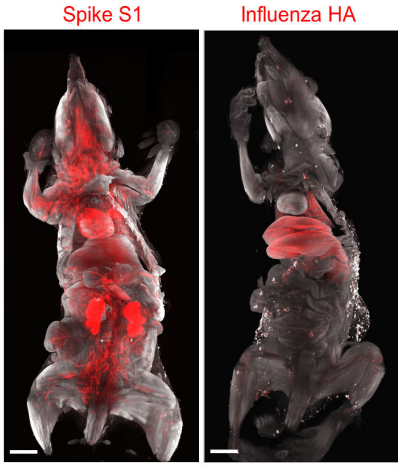No Amount of Hand-Washing Can Make COVID-19 a Seasonal Virus
Needless to say, words have meaning. The selection of words modulates the message understood by the receiver. With regard to COVID, terms such as “seasonal”, “like a cold”, and “like the flu” can be selected by writers to paint a portrait that lulls the reader into a false sense of security, drawing comparisons between a virus that has been around for less than five years to other viruses or conditions with respect to which the audience has grown familiar with. Moreover, even stock photos selected for certain news articles can subtly influence your response to the content expressed in that piece. A selected photo of a person gently cradling a tissue paper over their nose, instead of a person waiting for treatment in the ER, may give off the impression that they are harmlessly recovering from a tear-jerking soap opera instead of from a viral illness. In fact, we want to believe that COVID-19 is as gentle as a cold, as this outcome is far more pleasing, so this skewed presentation of the risk is far more palatable than what is expressed in the scientific literature.
However, COVID-19 is not a cold or the flu. Understanding that this virus is not a seasonal nuisance like the common cold is crucial in the fight against it, as explained herein.
We emphasize that the purpose of this piece is to correct some of the language circulating in the media and to arm you with accurate information so that you can make reasoned decisions that are aligned with your health goals. As much as an athlete who is training for a triathlon may want to avoid regularly smoking or taking recreational drugs, COVID-19 should be factored into your day-to-day health decisions, especially if you are conscious about achieving a greater, healthy lifespan.
But before delving into a comparison between COVID-19 and the flu, here is a primer on COVID-19.
A COVID-19 Primer
Long Term Risk
COVID-19 continues to present an important risk to your long-term health. This means that after you test negative, you can still develop medical conditions or disorders that can impact your quality of life as a result of that COVID infection. In other words, the cost of COVID on your life is not just the loss that you experience as you wait for your negative test. While individuals can remain infectious for an average of 10 days [1], the disease often takes a toll that can manifest months to even years after your acute-stage infection. COVID can take away the opportunity of a professional athlete to join a national team, or from competing in an Olympic event for which the athlete has been training for years [2]. COVID can rob a doctor, a nurse, a teacher, or a lawyer, of a successful career. COVID can disrupt the health of a family. And this can happen after every infection, not just after your first infection. The odds of developing long-term conditions add up after each infection. Despite reducing the risk to varying degrees ranging from 15% to 50%, vaccinations do not eliminate the problem. For these reasons, it is important for you to appreciate how, and when, COVID circulates and can infect you.
How Do You Catch COVID?
COVID spreads principally through the air. This means that handwashing is not the key solution for keeping you safe from COVID. Now, handwashing is a good practice, but you need to become mindful of the air that you breathe in order to protect your health and future, as well as those of your loved ones, from this disease. Just like you would not drink stagnant water from a pond in the city, do not inhale unfiltered dirty air. You can filter your air by wearing N95 masks (respirators) or better. Favor outdoor air over indoor air. Clean the indoor air by using HEPA filters to remove the virus. Dilute contaminated indoor air by bringing in clean outdoor air through ventilation. The World Health Network has released numerous resources on this topic [3-5].
When Does COVID Spread? The Myth Regarding Seasonality
News outlets have been circulating the hope that COVID is a seasonal virus, with little-to-no transmission during the warmer days of the year. However, at the time of writing this piece, in Summer 2024, the U.S., the UK, and many countries around the world are currently experiencing a major COVID wave.
We have learned over the last few years that COVID-19 does not follow seasonal patterns. COVID waves are not merely a fall or winter phenomenon, nor do they follow any other predictable seasonal pattern.
This distinction from seasonal pathogens, such as influenza, is crucial for several reasons and highlights the unique challenges and dangers posed by this novel coronavirus. As seasonal viruses infect people predominantly in the cold winter months, this makes those colder months more dangerous and other months less dangerous for those viruses. Examples of such diseases include the flu, rhinovirus, RSV, parainfluenza viruses, adenoviruses, enteroviruses, and human metapneumovirus.
Mind Your Health During the Summer
As countries are currently experiencing a significant summer surge of COVID-19, if you are trying to take your well-earned holiday, working in the office during the summer months, or are an athlete aiming to break a world record at the 2024 Olympics, you are at risk of contracting COVID-19 this summer [6].
You can monitor the amount of COVID-19 spreading in your region by consulting wastewater readings. The amount of COVID-19 detected in the wastewater can be related to the number of infected individuals in that region. However, unlike your weather forecast, wastewater is backward-looking and not forward-looking. Therefore, look at the trend to anticipate where the data is going. Is the wastewater showing a steep incline, or a steep decline?
Wastewater readings enable us to detect the presence of a surge. For illustration purposes, we draw your attention to the following government webpages showcasing wastewater levels:
- the U.S.: the CDC provides a color chart indicating wastewater levels: https://www.cdc.gov/nwss/rv/COVID19-currentlevels.html
- Canada: the government of Canada provides biweekly wastewater readings: https://health-infobase.canada.ca/wastewater/
Wastewater levels in many countries show a rapid increase in detected COVID-19 this summer. This rise in wastewater levels also heralds an increase in COVID-related hospitalizations and deaths [7].
This means that even during the hotter days of the year, a level of caution regarding COVID-19 is strongly warranted, as we experience COVID-19 infections during the summer as well as the fall, winter and spring. Unlike many of the respiratory viruses that you are accustomed to, COVID is not seasonal. You can enjoy a COVID-19 infection anytime during the year, as COVID-19 surges can manifest at any time.
The Deceptive Severity of COVID: More Like Chain Smoking than the Flu or a Cold
COVID-19 is not primarily a respiratory infection. This virus can cause a systemic disease with far-reaching effects on the body, particularly the blood vessels. Once SARS-CoV-2 enters the body, the virus can affect the endothelial cells that line blood vessels, causing inflammation and damage. This widespread endothelial damage leads to clotting and has significant implications for organs and systems.
This is where the challenge lies in understanding the risk that this virus poses to our health. The virus enters primarily via the respiratory tract, but then goes on to infect your organs across your body via your blood vessels. You may only feel the effect that the virus has on your respiratory system and a general feeling of malaise or fatigue during your acute-stage infection. You may be misled, based on these initial symptoms, into believing the false comparison that this virus is as gentle as your last cold. However, the virus is also attacking your other organs. You may not be aware of it until health conditions or medical disorders manifest months or even years after that initial infection. Just like the chronic smoker who may not be aware of the degradation of their health during the first months of smoking, so are you not necessarily able to detect this damage following the acute stage of your COVID-19 infection. And this is where the challenge lies for you: just like with any life choices that you make to preserve your health, you cannot trust how you feel during those days or weeks following your initial infection as a reliable metric of what health consequences have truly transpired from that infection. Instead, relying on the thousands of scientific publications illustrating the damage that COVID does to your long-term health is painting a more accurate portrait of your health following your COVID experience.
For instance, the complications from COVID-19 can include severe respiratory distress due to the damage done to blood vessels in the lungs. The virus also has the capacity to inflict damage on the heart, kidneys, liver, and even the brain. The virus can cause blood clotting which can in turn cause strokes and heart attacks. This is not typically seen in seasonal flu-like infections, which are generally confined to the respiratory tract. A particularly telling illustration of this difference is found in a scientific paper reporting on the use of fluorescence to illustrate the systemic (full body) nature of a COVID-19 infection when compared to the flu (see Figure 1 and Ref. [8]). The color red shows what parts of the mouse’s body were infected by the virus. The red color is confined to the airways of the mouse infected by influenza. However, the SARS-CoV-2-infected mouse is almost entirely red. This shows that SARS-CoV-2 was found almost everywhere in the mouse:

Furthermore, the phenomenon of “Long COVID,” where individuals continue to experience symptoms for weeks, months, or even years after the acute stage of the COVID infection, underscores the chronic impact of this virus. Symptoms of Long COVID can include persistent fatigue, difficulty breathing, brain fog, and a myriad of other health issues that severely impact your quality of life. This prolonged state of illness extends beyond what is commonly observed with seasonal flu, which typically resolves within days to weeks with much fewer lasting effects.
Each reinfection with COVID-19 increases the risk of these severe outcomes. Studies have shown that subsequent reinfections can compound the health risks. This accumulation of damage results in an increased prevalence of chronic health problems and disability within the population, increasing the need for medical care and other supportive services.
The implications are profound. The ongoing health impacts of COVID-19 extend not just to the individuals who suffer directly from the virus, but also to wider society. The chronic nature of the damage inflicted by COVID-19 has long-lasting economic ramifications, from increased healthcare costs to loss of productivity due to long-term disability, loss of intellectual function, and decreased quality of expert and specialist work.
Finally, adults get the flu on average once every five years [9]. Not even five years have passed since COVID has entered our lives. How many times have you been infected during this short period?
Public Health Strategies: A Required Revolution
Given these critical differences, a seasonal flu approach is not sufficient to manage COVID-19. While seasonal flu can typically be managed with annual vaccinations and familiar public health measures, SARS-CoV-2 demands a far more aggressive, sustained, and adaptive approach.
We should strive to slow down the continuous emergence of new variants by reducing opportunities for the virus to infect new hosts. Evidence is growing that SARS-CoV-2 can stay in your body after your acute infection, and can also remain active for months in immunocompromised individuals. These individuals can also be the source of hypermutated strains of COVID which have some resistance to vaccines, tests, and treatments, leading to new surges. Therefore, a COVID management strategy would benefit from first reducing the spread of this disease. This includes maintaining sources of information that enable us to evaluate its spread in a local population, where mitigating measures can be modulated based on the gathered data. This is why decisions such as that of the Ontario government to kick to the street its world-leading wastewater monitoring program is a step backward and a blow to those of you who are living in Ontario [10]. Public health strategies must prioritize robust surveillance systems to track the spread of the virus, identify emerging variants, and respond swiftly to outbreaks. This includes maintaining capacity for widespread testing and contact tracing even during periods of lower transmission.
In addition, ongoing scientific research and frequent updates to vaccines to ensure that they continue to offer effective protection against the latest strains would be advantageous. This requires a dynamic vaccine development pipeline, capable of rapid adjustments in response to viral mutations.
Public awareness and communication efforts also need to be accurate, consistent and persistent. Educating the public, particularly healthcare workers who should be sources of health information and who are entrusted with the health of their patients, about the airborne nature of the virus, the importance of ventilation and masking, and the real risks associated with reinfection, particularly Long COVID, is vital. People must understand that COVID-19 is not a short-term crisis, but a persistent threat that requires ongoing vigilance.
Finally, protecting the most vulnerable populations remains a crucial aspect of managing COVID-19. This involves not just vaccination but also ensuring equitable access to safe healthcare and support services for those suffering from long COVID and other post-infection complications.
In conclusion, COVID-19 (SARS-CoV-2) presents unique challenges that distinguish it sharply from seasonal influenza. Its ability to spread through the air, coupled with its vascular nature, resulting in severe impacts on multiple organ systems and the potential for long-term health issues, necessitates a comprehensive, adaptive public health response that goes beyond the typical seasonal flu strategies. You should be cautious about this virus. Comparing COVID-19 to a cold or the flu will lead you to underestimate how badly this virus can ruin your health. However, you have tools with which to protect yourself, particularly masking with N95 respirators or better to prevent inhaling the virus. And the more of us who evolve to face the reality of this virus, instead of allowing the virus to evolve to rob us of our health, the less this virus will impact our collective quality of life. You can take ownership over your own health, regardless of the season.
See also:
https://www.cdc.gov/ncird/whats-new/covid-19-can-surge-throughout-the-year.html
References
[1] Puhac et al. “SARS-CoV-2 viral load and shedding kinetics”, Nat Rev Microbiol. 2023; 21(3): 147–161, https://www.ncbi.nlm.nih.gov/pmc/articles/PMC9716513/ (consulted on August 9, 2024)
[2] Nathan Ikon Cumpton, “An Olympian’s Long Covid Journey”, YouTube, https://www.youtube.com/watch?v=bGKyA7tIvG0 (consulted on August 9, 2024)
[3] https://whn.global/guidelines-for-individuals-and-institutions/
[4] https://whn.global/category/prevention/
[5] https://whn.global/whn-science-communications/
[6] Sgobba, Christa. “Paris 2024 Was Supposed to Be ‘Normal’—But You Can’t Compete With COVID”, SELF, August 2 2024. https://www.self.com/story/covid-paris-olympics-2024 (consulted on August 3, 2024)
[7] “New Covid FLiRT variant causes spike in UK deaths and hospitalizations. Know in details”, The Economic Times, July 13, 2024. https://economictimes.indiatimes.com/news/international/us/new-covid-flirt-variant-causes-spike-in-uk-deaths-and-hospitalizations-know-in-details/articleshow/111719864.cms?from=mdr (consulted on August 3, 2024)
[8] Rong et al. “SARS-CoV-2 Spike Protein Accumulation in the Skull-Meninges-Brain Axis: Potential Implications for Long-Term Neurological Complications in post-COVID-19”, Cold Spring Harbor Laboratory, April 5, 2023, https://www.biorxiv.org/content/10.1101/2023.04.04.535604v1 (consulted on August 3, 2024)
[9] Roberts, Michelle. “Adults get flu ‘about once every five years”, BBC, March 4, 2015, https://www.bbc.com/news/health-31698038 (consulted on August 3, 2024)
[10] Nikiforuk, Andrew. “The Risks of Killing a COVID Early Warning System”, The Tyee, August 1, 2024, https://thetyee.ca/Analysis/2024/08/01/Risks-Killing-COVID-Early-Warning-System/ (consulted on August 3, 2024)


